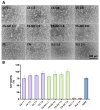Development and Evaluation of Graphene Oxide-Enhanced Chitosan Sponges as a Potential Antimicrobial Wound Dressing for Infected Wound Management
- PMID: 40806531
- PMCID: PMC12347233
- DOI: 10.3390/ijms26157403
Development and Evaluation of Graphene Oxide-Enhanced Chitosan Sponges as a Potential Antimicrobial Wound Dressing for Infected Wound Management
Abstract
Chronic infected wounds remain a major medical challenge, particularly in the context of increasing antibiotic resistance. The objective of this study was to develop and evaluate chitosan-based (CS) sponges enhanced with graphene oxide (GO) as potential antimicrobial wound dressings. The composite sponges were fabricated using microcrystalline CS (MKCh) and 5% (w/w) GO, followed by freeze-drying and γ-sterilization (25 kGy). Physico-mechanical characterization showed that GO incorporation did not significantly alter tensile strength, while absorption and sorption capacities were improved, especially after sterilization. Structural and spectroscopic analyses confirmed increased porosity and molecular interaction between CS and GO. Cytocompatibility was verified in vitro using L-929 fibroblasts, with no cytotoxic effects observed in indirect contact. Antimicrobial activity tests demonstrated that GO-modified dressings exhibited enhanced activity against E. coli and S. aureus, though results were strain-dependent and not uniformly superior to CS alone. Notably, antifungal efficacy against C. albicans was reduced with GO addition. Overall, the developed GO-enriched CS sponges present favorable biocompatibility, mechanical resilience, and selective antimicrobial activity, supporting their potential application in chronic wound management. Further optimization of GO concentration and formulation is warranted to maximize antimicrobial efficacy across a broader spectrum of pathogens.
Keywords: antimicrobial activity; biocompatibility; chitosan; dressings; graphene oxide; infected chronic wound.
Conflict of interest statement
The authors declare that they have no known competing financial interests or personal relationships that could have appeared to influence the work reported in this paper.
Figures





References
-
- Sikder S., Toha M., Anik A.H., Sultan M.B., Alam M., Parvin F., Tareq S.M. A Comprehensive Review on the Fate and Impact of Antibiotic Residues in the Environment and Public Health: A Special Focus on the Developing Countries. Water Environ. Res. 2024;96:e10987. doi: 10.1002/wer.10987. - DOI - PubMed
MeSH terms
Substances
LinkOut - more resources
Full Text Sources

